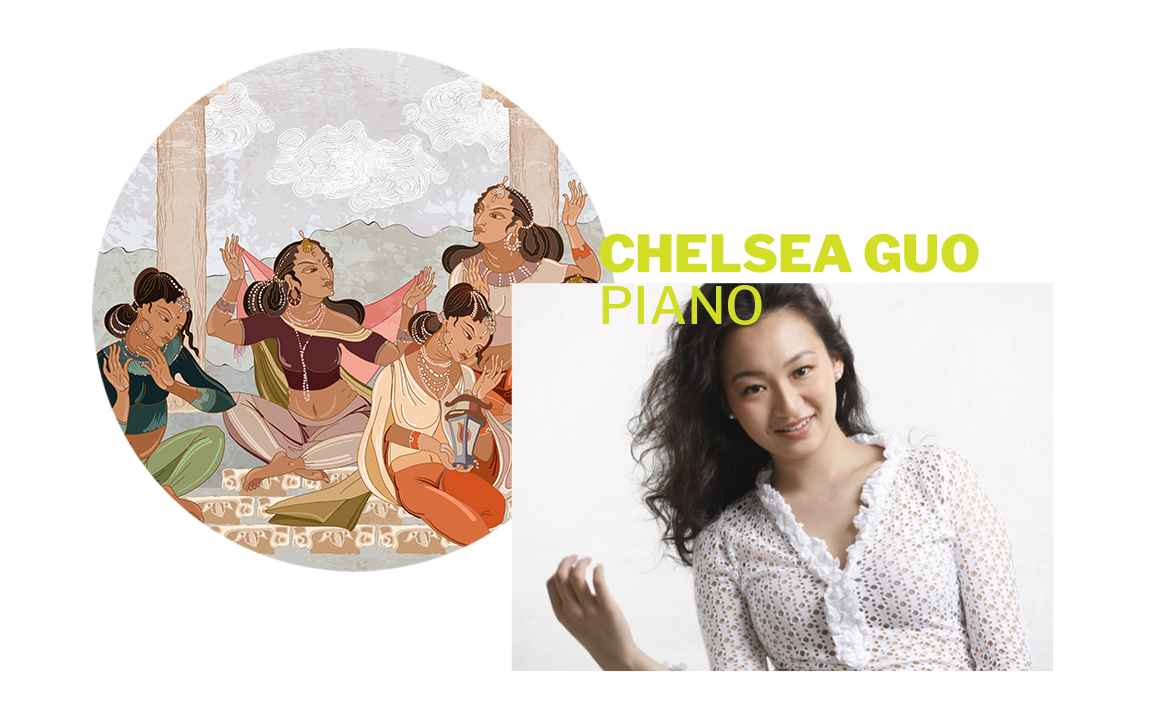1001 Nights – How Scheherazade Kept Her Head
Saturday, May 4 at 7:30pm
Sunday, May 5 at 3:00pm

1001 Nights – How Scheherazade Kept Her Head
Saturday, May 4 at 7:30pm
Sunday, May 5 at 3:00pm

1001 Nights – How Scheherazade Kept Her Head
Saturday, May 4 at 7:30pm
Sunday, May 5 at 3:00pm

The Palace Series
Experience the thrill of a live, full orchestra
Location
The Palace Theatre
61 Atlantic Street, Stamford, CT 06901
Duration
2 hours with a 20
minute intermission
Share With
About this performance
In our season of storytelling our final symphonic concert brings some of the greatest music storytelling ever — Nicolai Rimsky Korsakov’s epic work, Scheherazade. Four of the tales from the celebrated Arabian Nights are brilliantly recast in music of unmatched color and power. As the story goes, furious at his wife’s infidelity, the Sultan decides to take a new wife every day, only to have her killed the next morning. He did not reckon coming across the will of the beautiful Scheherazade.
Each night, she spins tales of such intrigue, suspense, and fascination that come morning, the Sultan stays her execution, hooked by the thought of hearing the next installment that evening. After 1,001 of these well-told tales, the Sultan’s cruel plan is no longer, and he relents. You will be mesmerized by this shimmering musical story. This is sure to be a glorious close to a glorious season.
Hear Michael Stern, Chelsea Guo and Kate Remington of WSHU discuss this concert. Click here.
Chelsea Guo, piano
Michael Stern, conductor
Musical Program to include
Quinn Mason A Joyous Trilogy
Edvard Grieg Piano Concerto
Nicolai Rimsky-Korsakov Scheherazade
Concert sponsor:
Your Orchestra Lumos Experience
Join Us for Illuminating discussions hosted before and after concerts
Behind the Baton: Held in the theater one hour prior to each concert
Learn more about the program with Music Director Michael Stern. This pre-concert talk offers a deeper
look into the music and introduces you to the soloist.
After Hours: Held in the lower lobby café following Saturday evening concerts
Michael Stern moderates an interactive discussion after the concert with a panel of guests (musicians, composers, and community leaders). Join us for a glass of wine and feel free to ask questions and share your own thoughts!
Sharing the Joy of Music with Young Audiences
Orchestra Lumos is dedicated to broadening access to, and appreciation of, musical experiences for young
audiences. Kids ages 5 to 17 come FREE* with accompanying adult for Sunday afternoon concerts. (* $4 facility fee is applied to all tickets ordered).
Featured Artists
Chelsea Guo piano

The year 2022 has been an exciting one for Chelsea Guo. In November, she was named one of four winners of the 2022 Young concert Artists (YCA) Susan Wadsworth International Auditions, affording her management services and expanded concert opportunities. Earlier in the year, Chelsea was proud to be included in “Classic FM’s Rising Stars: 30 Brilliant Musicians We’re Celebrating in 2022”. An artist who has already attracted international attention as a pianist and soprano of remarkable gifts, her dual artistry is featured in her 2021 debut recording on the Orchid Classics label, “Chelsea Guo: Chopin in My Voice”, which includes beloved Chopin solo repertoire, along with two Chopin songs and one Rossini aria in which the artist accompanies herself. The inclusion of the Rossini aria is typical of many of the concert programs Chelsea offers, which include both piano and vocal works, enriching the opportunity for her audience to experience music in a broader context and displaying the influence that singers had on composers of their time. Gramophone Magazine included the recording in their Essential New Albums and Classic FM featured Chelsea for an entire week as a “Young Classical Star.” The album reached #7 on the Billboard Traditional Classical Chart and received five stars from BBC Music Magazine, which wrote: “A very fine pianist with a beguiling voice;Here is a rare talent.” In China, all of the major digital music platforms prominently displayed the recording on their homepages. Both WQXR and Naxos China highlighted it among “The Best Albums of the Month.”
Chelsea’s 2021-22 season began with her German debut at the Moritzburg Festival as both pianist and soprano, and appearances in both capacities with Orchestra Lumos and Michael Stern in their season opening gala, as well as an hour-long return visit to radio station WQXR’s Young Artist Showcase. It continued similarly with the New Jersey Symphony and Maestro Xian Zhang, her Spain debut with the prestigious Sociedad Filarmonica La Coruña, her collaboration with the Oregon Mozart Players and Kelly Kuo in the closing concert of their 40th anniversary season, and her debut at Lincoln Center’s Alice Tully Hall with the New Jersey Symphony and Maestro Zhang, in Chen Qigang’s “Er Huang Piano Concerto”. Having won a top prize in the 2020 National Chopin Piano Competition in Miami, Chelsea’s 21-22 season also included recitals in Florida for the Chopin Foundation of the United States, the Grand Piano Series, and the Miami International Piano Festival.
Chelsea started the 2022-23 season with a recital in Cremona, Italy, at the invitation of the Fazioli family, which was part of the Cremona Musica and Fazioli Piano festivals. She traveled immediately thereafter to London to participate in a live filming with Sky TV, which featured a group of young artists chosen by Classic FM as their “Rising Stars for 2022”. Chelsea performed with the Jupiter Symphony Chamber Players, “Model Room Musicales” of New York Yacht Club, and made concerto appearances with the New Jersey and New Haven symphonies. Later in the season, she performed at the Hess Myra Concerts with Chicago Classical Music Radio Station and gave her Boston debut recital with the Foundation of Chinese Performing Arts. She also appeared as both solo pianist and solo vocalist with Mainly Mozart Festival in San Diego.
Chelsea’s solo piano performances have taken her to Carnegie Hall, London’s Wigmore Hall, as well as prominent venues throughout the United States, England, Austria, France, Poland, Italy, Spain, China, Japan and Canada. A guest artist of the Leeds Inaugural Piano Festival, she was also featured in Europe in solo recitals presented by the Mozarteum Summer Series in Salzburg, and in China, in a six-concert tour under the auspices of the Shenzhen Piano Music Festival. Her orchestral appearances have included the Ft. Worth Symphony, under the baton of Maestro Barry Douglas, and the Torun Symphony Orchestra in Poland. Chelsea was honored to be a Young Scholar of the Lang Lang Foundation, a young artist of the Artemisia Akademie at Yale, and a recipient of the US Chopin Foundation scholarships for four consecutive years.
Chelsea’s passion for piano was mirrored by her love of singing from an early age. Having debuted as a pianist with the Tianjin Symphony Orchestra at age nine, she returned in 2018 as vocal soloist under the baton of Maestro Muhai Tang. She has been recognized for her vocal gifts as a 2019 National YoungArts winner, the first prize winner in the 2019 Schmidt Voice Competition, and recipient of scholarships from the George London and Gerda Lissner foundations.
Chelsea graduated with honors from the Juilliard School’s Pre-College as a double major in piano and classical voice, studying with Hung-kuan Chen, Tema Blackstone and Lorraine Nubar. She is currently pursuing a Bachelor of Music in piano at Juilliard under the tutelage of Hung-Kuan Chen and continuing her vocal studies with Jason Ferrante. She has welcomed the opportunity to be mentored by renowned soprano, Barbara Bonney, over the past five years.
Program Notes
A Joyous Trilogy
Quinn Mason
b. 1996
Composed in 2019 on commission from Orchestra Seattle and Seattle Chamber Singers, and revised in 2021, the three-movement A joyous Trilogy is just what the title implies. The composer writes that he “wanted to create a composition that was the very embodiment of happiness and cheerfulness, an accessible work that would put any listener in a good mood. The first movement, ‘Running’ is so called because of its always-moving and seemingly never-waning energy that keeps going and going. The second, ‘Reflection,’ is a gentle and introspective meditation featuring a solo trombone. The third, ’Renewal,’ picks the energy back up, but a little more spirited and zestful this time, and keeps it going to the very end, complete with dynamic and vibrant interplay between all the orchestral sections.”
Quinn Mason is a Dallas-based composer and conductor. He studied composition at the MSU Meadows School of the Arts, and at the University of Texas in Dallas. He is currently Artist-in-Residence of the Hartford Symphony Orchestra.
Piano Concerto in A minor, Op. 16
Edvard Grieg
1843-1907
The most successful and best known of nineteenth-century Scandinavian composers, Edvard Grieg, was one of the great exponents of Romantic nationalism. He saw it as his role in life to bring Scandinavian musical and literary culture to the attention of the rest of Europe. As composer, pianist and conductor he became a sought-after fixture in Europe’s music centers. His wife Nina was an accomplished singer, and the two traveled extensively together, popularizing his songs and piano works. In the process, he also helped introduce to the rest of Europe the writings of Scandinavian poets and dramatists, particularly Henrik Ibsen, for whose play Peer Gynt he composed incidental music.
As a student Grieg had been a failure. He quit school at 15 never to return. Under the sponsorship of Norwegian violinist Ole Bull, he was granted a scholarship to the Conservatory in Leipzig but hated his teachers and never forgave them their conservatism and pedantry. Understandably, he was not happy with the constraints of the classical sonata form; of all his surviving output, only eight works fall into this category. In all his other compositions he insisted on the freedom of form so dear to the Romantic tradition. He felt most comfortable with, and excelled in, smaller musical forms: songs, miniature piano pieces, orchestral dances and re-workings of folk melodies. His aptitude for orchestration was indifferent at best. It is, therefore, surprising that the Piano Concerto, his only completed large-scale orchestral work outside of the student symphony, would end up as one of the most popular Romantic concertos.
Composed in 1868 and revised extensively five times, the last revision coming shortly before the composer’s death, the Concerto was modeled after the Piano Concerto of Robert Schumann, with considerable Lisztian influence. Franz Liszt was Grieg’s idol, and he consulted with the older composer on phrasing and piano technique, particularly in the large cadenza. While the Concerto’s themes are not ethnic Norwegian – it was written before Grieg became interested in Norway’s folk music – it still has a “Northern” mood and does incorporate Norwegian dance rhythms. Initially, the Concerto was not well received; its apparent introverted style was foreign to a public used to the fire and bravura of concerti à la Liszt. Ironically, it was the enthusiastic endorsement by Liszt himself that turned the tide and converted both audiences and pianists to the work. Later in his life – his hero worship notwithstanding – Grieg had second thoughts about some of Liszt’s suggestions, and in the last revised version removed some of the latter’s more bombastic additions. This final version is the one commonly heard today.
Emulating his models, Grieg opens the Concerto with a strong piano declamation, spanning almost the entire range of the keyboard and followed by a wave of arpeggios before the first theme appears in the orchestra. Only then is the theme taken up by the piano and elaborated. The cellos introduce a lyrical second theme although in the earlier versions Grieg had scored it for the trumpets (probably on Liszt’s advice). The written-out cadenza is expansive and, of course, technically challenging. The second movement Adagio is a tender song-like theme on muted strings. When the piano finally enters, it gently embellishes the theme.
It is in the last movement that Grieg’s folk impulses break out in a Norwegian dance, the halling. But a gentle middle section introduced by the flute with string accompaniment serves as a contrast to the ebullient dance. After a brief cadenza, the soloist launches into a coda recasting the dance theme into the rapid triple time of the popular Norwegian springdans. The Concerto ends with the gentle flute theme now thundered out by orchestra and soloist.
Scheherazade, Op. 35
Nikolay Rimsky-Korsakov
1844-1908
In the tradition of Russian national music, Nikolay Rimsky-Korsakov holds a place of honor. Musically self-taught, he originally trained as a naval officer, serving in that capacity from 1862 to 1873. Throughout his naval career he studied music on the side until 1871 when he won a faculty position at the St. Petersburg Conservatory in spite of the fact that he had little formal training. Until his death he taught and encouraged nearly every young Russian composer from Alexander Glazunov and Anton Arensky to Igor Stravinsky and Sergey Prokofiev.
Rimsky-Korsakov’s inspiration derived from the operas of Mikhail Glinka, whose music combined Russian melodies with the oriental modes of Russia’s vast Eastern provinces. Together with César Cui, Aleksander Borodin, Mily Balakirev and Modest Mussorgsky, he formed the group called “The mighty five,” whose aim was to promote Russian national music. Ironically, Rimsky-Korsakov was by far the best-trained musician among them. His use of instrumental color and masterly orchestration was so famous that any Russian composer with serious aspirations made the pilgrimage to his orchestration and composition classes, even occasional foreigners, like Ottorino Respighi who came from Italy. After the deaths of Borodin and Musorgsky, Rimsky-Korsakov edited and completed their manuscripts – especially their operas – and had them published. Unfortunately, he had a habit of “correcting” everything that he considered over the top, from harmonic progressions to the order of scenes.
The symphonic poem Scheherazade, based on A Thousand Nights and One Night (commonly called the Arabian Nights) was composed in 1888 and premiered in November of that year. It is among the most colorful works in the orchestral repertoire, glowing with brilliant orchestration and lush solos. The frame story of A Thousand Nights and One Night tells of a Khalif who was in the habit of killing his wives after a single night of lovemaking. His latest bride, Scheherazade, avoids that fate by telling him suspenseful stories, concluding each evening with a cliffhanger. After years of such nightly entertainment, the Khalif finally decides to keep her.
The Suite comprises four tableaux, in which the yarn-spinning Scheherazade “speaks” through virtuoso passages for solo violin. Her theme ties the tableaux together and is occasionally incorporated into a story. None of the four tableaux, however, is a specific musical setting for any of Scheherazade’s tales; rather, they allude to the character types and incidents that make up the vast body of stories. The tone poem begins with the low brasses blasting out the theme representing the Khalif, followed by a passage that Rimsky snitched – although he modified it harmonically – from Mendelssohn’s Overture to A Midsummer Night’s Dream, denoting the world of fairytales.
The first tableau, “The Sea and Sinbad’s Ship,” includes a combination of rhythms and changing dynamics that imitate the motion of the waves by means of two principal themes: the second one is a transformation of the Khalif’s theme while Scheherazade’s theme is transformed to fit the rocking of the waves.
“The Tale of the Kalendar Prince” changes the pace to reflect a number of loosely bound battle episodes, including a main theme introduced in an English horn solo, and virtuosic fanfare passages for solo trumpet.
The third tableau, “The Young Prince and the Young Princess,” is the most romantic. The violins introduce the first intimate theme, followed by an Oriental dance
The final tableau is a passionate conversation between the Khalif and Scheherazade, as she readies herself for her last chance at survival. The tableau actually recalls a number of episodes from her repertory of stories; marked in the score are: “The Festival at Baghdad;” “The Sea” (reprise of the theme from the first tableau); “The ship founders on a rock topped by the bronze statue of a warrior;” and “Conclusion.” The music is fiery and exciting until the end, when Scheherazade’s stories come to a quiet and plaintive end as she awaits the verdict of the Khalif, whose theme finally moderates to a gentle section solo for the cellos.
Program notes by:
Joseph & Elizabeth Kahn
Wordpros@mindspring.com
www.wordprosmusic.com
*artists and programs subject to change







